- Home
- >>
space sargassoes, derelicts and clumps
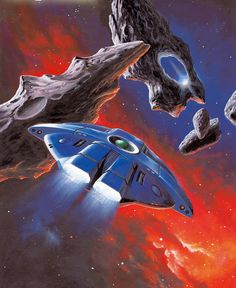
The void between the worlds isn't a mere uniform blank. Far from it. As any old space-hand will tell you, you can run into all sorts of stuff out there. As for instance in The Graveyard of Space -
...So Ralph watched and saw the dark jumble of rocks - silvery on one side where the distant sunlight hit it - apparently spread out as they approached it. Spread out and assume tiny shapes...
"Spaceships," Diane said. "Spaceship, Ralph. Hundreds of them."
They gleamed like silver motes in the sun or were black as the space around them. They tumbled slowly, in incredible slow motion, end over end and around and around each other, as if they had been suspended in a slowly boiling liquid instead of the dark emptiness of space.
"There's the sargasso," Ralph said...
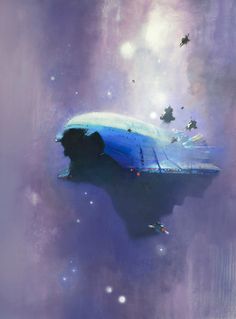
Stid: I suppose real science would agree, up to a point, with the tall tales of those Old Solar System space-hands. I mean to say, in the Real Solar System there's the Solar Wind... not to mention all kinds of meteoric junk, plus (as the Space Age advances) more and more items of human junk. So, yes, space isn't really empty. Come to think of it, if you believe string theory, space isn't even space...
Harlei: A noble effort at RSS/OSS reconciliation, Stid, but I very much doubt, with regard to the contents of the void, that reality has any chance at all of coming up to the mark, any more than it does with the surfaces of the planets.
Zendexor: I'm afraid Harlei's right here. For example, nothing in our impoverished actuality can match what we're given in Calling Captain Future -
the definitive sargasso
"We can't get out of this ether-current," Curt gritted. "It's too strong. And it's whirling us on into the most dangerous spot in space, one from which no interplanetary ship has ever escaped."
Joan's hand went to her throat. "You mean - "
Captain Future nodded grimly.
"Yes. We're being carried into the Sargasso Sea of Space."
...The legendary, mysterious peril to navigation that was dreaded by every space-sailor in the System!
Captain Future explains - to his passenger Kansu Kane, and to the reader -
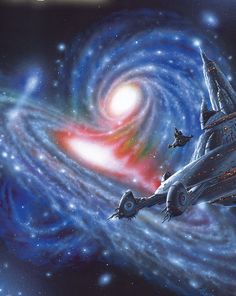
"...there are many strong ether-currents, strange running tides in the luminiferous ether itself, out in this part of the System. They all flow into a central vortex, and anything that is carried into the vortex can't get out again, against the currents. That central vortex is the Sargasso Sea of Space."
Curt reached for the throttles. "I'll try once more to break out of the current," he muttered. "But I'm afraid - "
He opened the throttles to the limits. It was futile. The power was not enough to get them out of the remorseless grip of the ether-current that was sweeping them fatally on into a dreaded, unknown region of space.
Captain Future shut off the rockets. "No go," he said, shaking his red head. "Might as well save our power, until we get into the central vortex. Then we'll see what we'll see..."
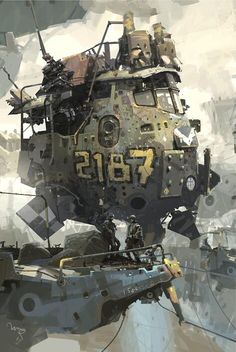
Tossed about on the mad currents, they eventually reach the calm, undisturbed centre of the ether-current whirlpool, where at last the spaceship floats "placidly as though on a millpond". And there they must stay - unless, somehow, they can devise a source of power strong enough to carry them out.
"Where do you expect to find any additional source of power in this empty hole in space?" Kansu asked hopelessly.
"There," said Captain Future quietly, pointing ahead.
They stared. Far ahead, a vast jumbled metal mass floated motionless in space. The mass was lenticular in shape, and hung at the very center of the dead-area...
As their craft hummed closer, they saw that this far-flung, jumbled mass was a great aggregation of space ships and debris of all descriptions. All this flotsam was held together by its own slight mutual gravitation.
"What is it?" Joan Randall whispered awedly.
"It is the graveyard of space ships," Curt said. "The last resting-place of every ship that has been sucked into the Sargasso Sea of Space since interplanetary travel began. No ship has ever escaped here - all that blundered in are still here."
He steered the space-boat straight toward the edge of the vast wreck-pack...
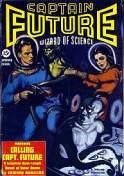 octopus-man in suspended animation
octopus-man in suspended animationOf course, they do find something they can use. An alien ship, crewed by monsters in suspended animation, furnishes the power-source they need, along with plenty of horror and excitement along the way. But there's more than just pulp-fictional thrills here. The memorable aspect of this episode is the unforgettable, haunting vista, hacked out in the simple prose typical of Captain Future.
...In the pack were space ships of every kind that had ever sailed the System. Great Jovian grain-boats, dumpy Martian freighters, streamlined liners from the Neptune and Uranus routes, black cruisers of the Planet Police, ominously armed pirate ships, even small space-yachts.
These dead ships floated, rubbing slowly against each other's sides. And between them and among them floated all kinds of interplanetary debris that had been swept into the maelstrom - meteors large and small, fragments of splintered asteroids, bits of metal wreckage, and stiff, space-suited bodies of dead men who perhaps had floated in the void for years before drifting into this last resting place.
Unutterably awe-inspiring was the sight, here in the thin, pale sunlight of outer space. Here was the end of many a brave-hearted voyage. Here many a good ship that had once throbbed from world to world had come to peace and quiet at last. Here was a Valhalla of space ships and space-men, whose eternal tranquility and silence would not be disturbed until the System ended...
a choice of sargasso origins
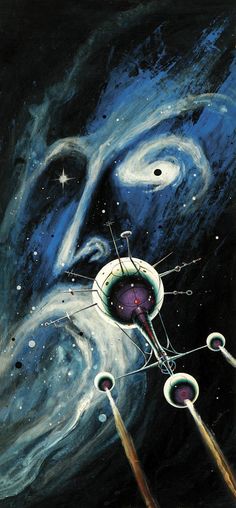
Ether-currents are what did it, in the Captain Future scenario. But there are other explanations. In The Graveyard of Space gravitation is enough -
Harlei: Gravitation of what?
Zendexor: More than one answer to that...
"...One theory is ships only, and maybe a couple of hunks of meteoric debris in the beginning. Another theory says there may be a particularly heavy small asteroid in this mass of wrecks somewhere - you know, superheavy stuff with the atoms stripped of their electrons and the nuclei squeezed together, weighing in the neighborhood of a couple of tons per square inch. That could account for the beginning, but once the thing got started, the wrecked ships account for more wrecked ships and pretty soon you have - a sargasso..."
But these rather involuntary processes don't have to count as the whole story.
a purposeful clump
Out of space flotsam and accumulated interplanetary graveyards, a further idea springs: could such clumps be created by political action or social pressure? Could they be the outer-space equivalent of shanty towns or gipsy encampments?
We can enter such a scene in Citadel of Lost Ships.
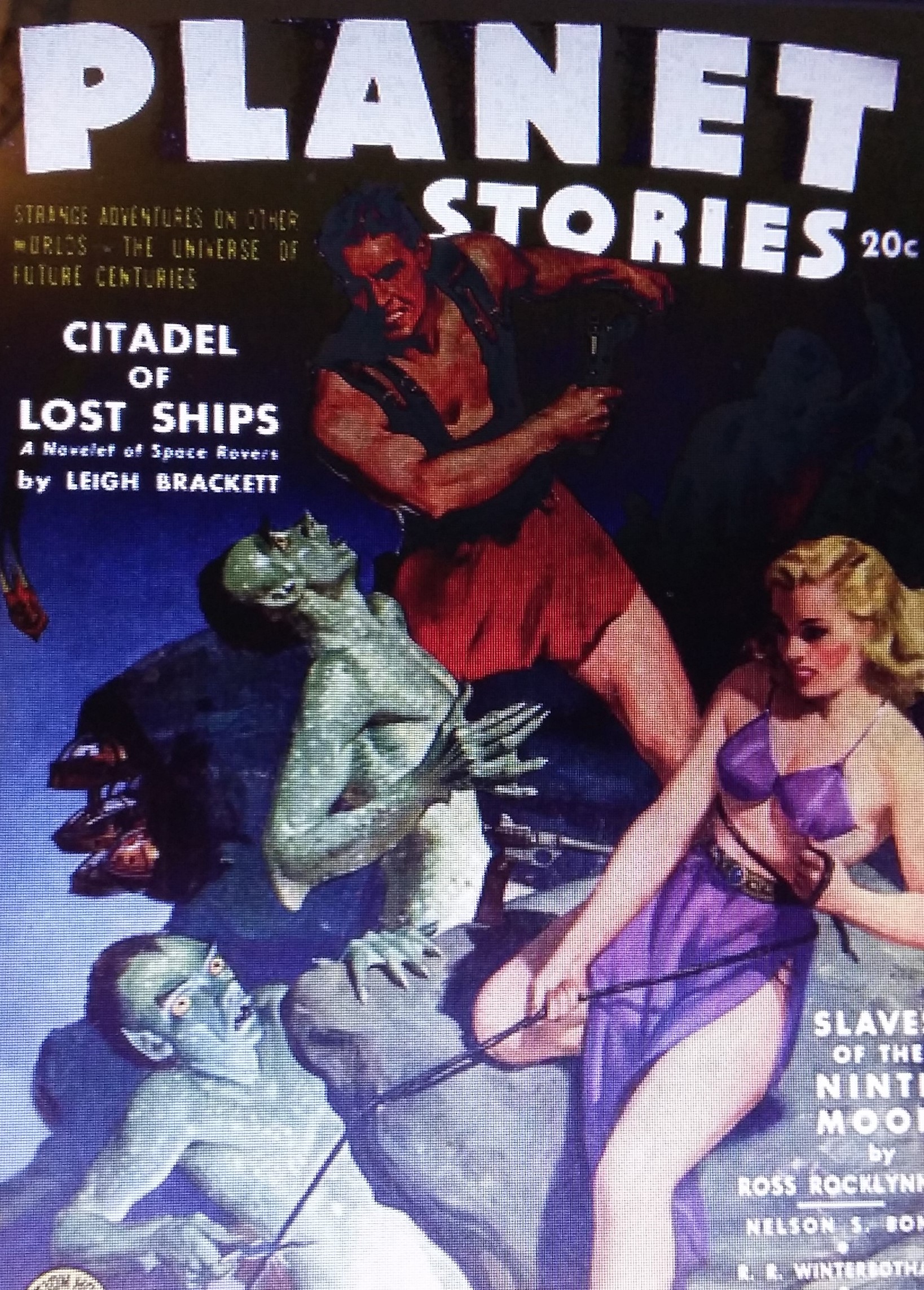
...A round, plate-shaped mass about a mile in diameter, built of three tiers of spaceships. Hulks, ancient, rusty, pitted things that had died and not been decently buried, welded together in a solid mass by lengths of pipe let into their carcasses... ...he thought it was the most desolate, Godforsaken mass of junk that had ever made him wonder why people bothered to live at all...
As in many of Brackett's swashes of fictional colour, some of the practical outlines are fuzzy and uncertain, but we can deduce that the "Citadel" is in orbit around Venus - for the time being, at any rate; it has the ability to shift location. A loose, mobile agglomeration of easily detachable ships, it's just kind of piped together, or so it seems, to judge from the following:
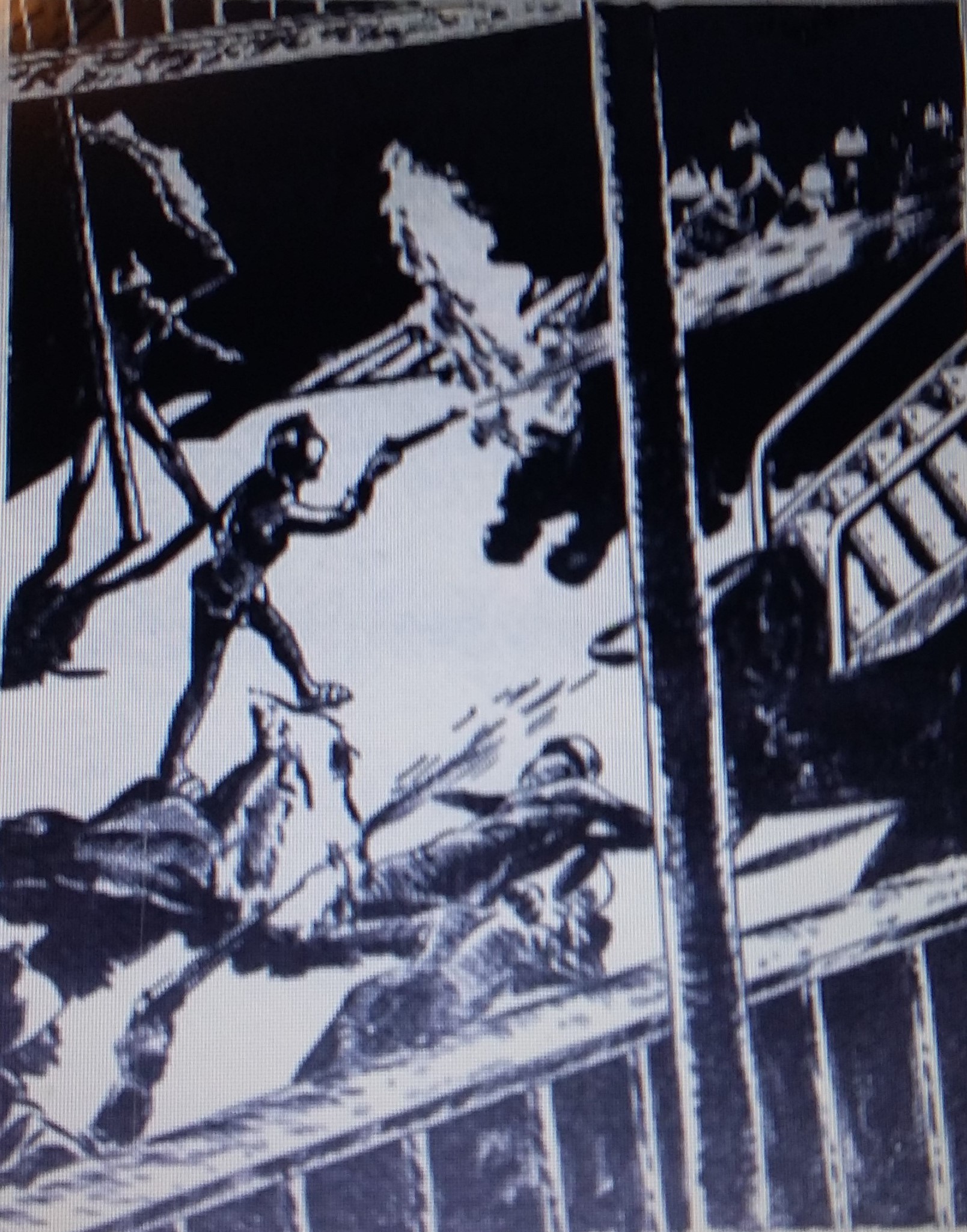

"...A long time ago there were a few ships. Old ships, crowded with people who had no homes. Little, drifting people who made a living selling their odd handicrafts in the spaceports, who were cursed as a menace to navigation and distrusted as thieves. Perhaps they were thieves. They were also cold, and hungry, and resentful.
"After a while the ships began to band together. It was easier that way - they could share food and fuel, and talk, and exchange ideas. Space wasn't so lonely. More and more ships drifted in. Pretty soon there were a lot of them. A new world, almost.
"They called it Romany, after the wandering people of Earth, because they were gypsies, too, in their way.
"They clung to their own ways of life. They traded with the noisy, trampling people on the planets they had been driven away from because they had to. But they hated them, and were hated, just as gypsies always are.
"It wasn't an easy life, but they were free in it. They could stand anything, as long as they were free. And always, anywhere in the Solar System, wherever some little lost tribe was being swallowed up and needed help, ships from Romany went to help them..."
More than an action-adventure, the tale is also an eloquent, passionate plea for the freedom of marginalized elements in society; the forgotten, the abandoned...
Harlei: Talking of abandonment, Zendexor -
Zendexor: Yes, I know, you're been waiting to get on to treasure-hunting. The romance of drifting derelicts in interplanetary space...
hulks of the void
It drifted there in space, to the right of the Sun, its spherical hull half illumined and half in shadow. No native of the solar system could have guessed either its age or its origin. Battered, lifeless, desolate and forlorn, it betrayed a kinship both with the remote past and with the distant stars against the sharp pinpoints against which its bulk was limned...
Thus begins Derelict, a Golden Age tale from the October 1935 Astounding Stories. The alien starship, in a wide orbit around Jupiter, turns out to be inhabited by an ancient robot -
Stid: Starship, eh? So this is, in a way, an interstellar rather than an OSS tale.
Harlei: Well, wouldn't you figure that the most spectacular derelicts are likely to have an extrasolar provenance? It still counts as OSS if the action occurs on our patch -
Stid: Yet the "pull" of such a plot is likely to be extrasolar. I mean, you rummage around, you discover how the ship's drive works, and then, bingo, you have the secret of star-travel, and away you go, and good-bye to the OSS.
Zendexor: However, that's not what actually happens in Derelict, and nor does it happen during the span of the later and longer novella, The Ship From Infinity.... I admit it's probably only a matter of time before humanity uses such a find for its original Galactic surveying purpose, but first - and still within our System's boundaries - the drifting giant has to be found and tamed.
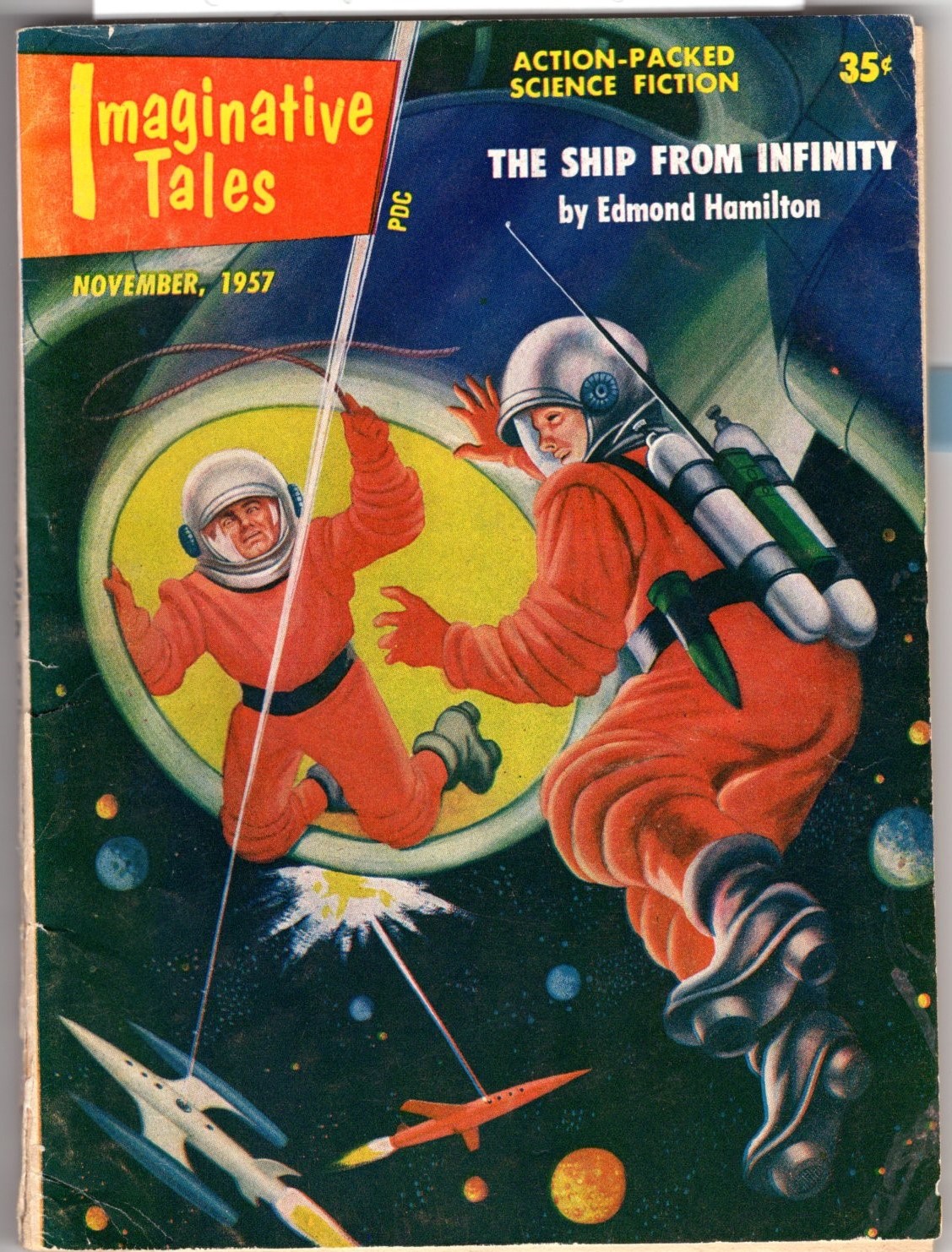
...They reached a point. An imaginary point, marked with an imaginary pencil on millions of miles of nothing.
They waited...
Whereas in Derelict the alien ship was about three hundred feet in diameter, in The Ship From Infinity the vessel is about two miles long. In the former tale the object is in orbit around Jupiter; in the latter, its age-long drift is as far off as could still be defined as the outermost reaches of the Solar System.
Otherwise - if it had been less remote - the inert alien colossus would surely have been discovered long before Ross Farrel and his fellow fugitives arrived on the scene.
...And it came. Ponderous, silent, and oh God, how incredibly huge and dark. A ship as big as a world and helpless as any dead thing, rushing headlong out of the void in pursuit of its endless and meaningless journey around an alien sun. The starlight burned on its iron flanks, on the humped discolored patches of stellar debris caught by its field of gravity and welded to it by long association.
The Ship. Legend, reality, wealth, danger, death.
They sprang at it, the six little tugs, motes beside a mammoth...
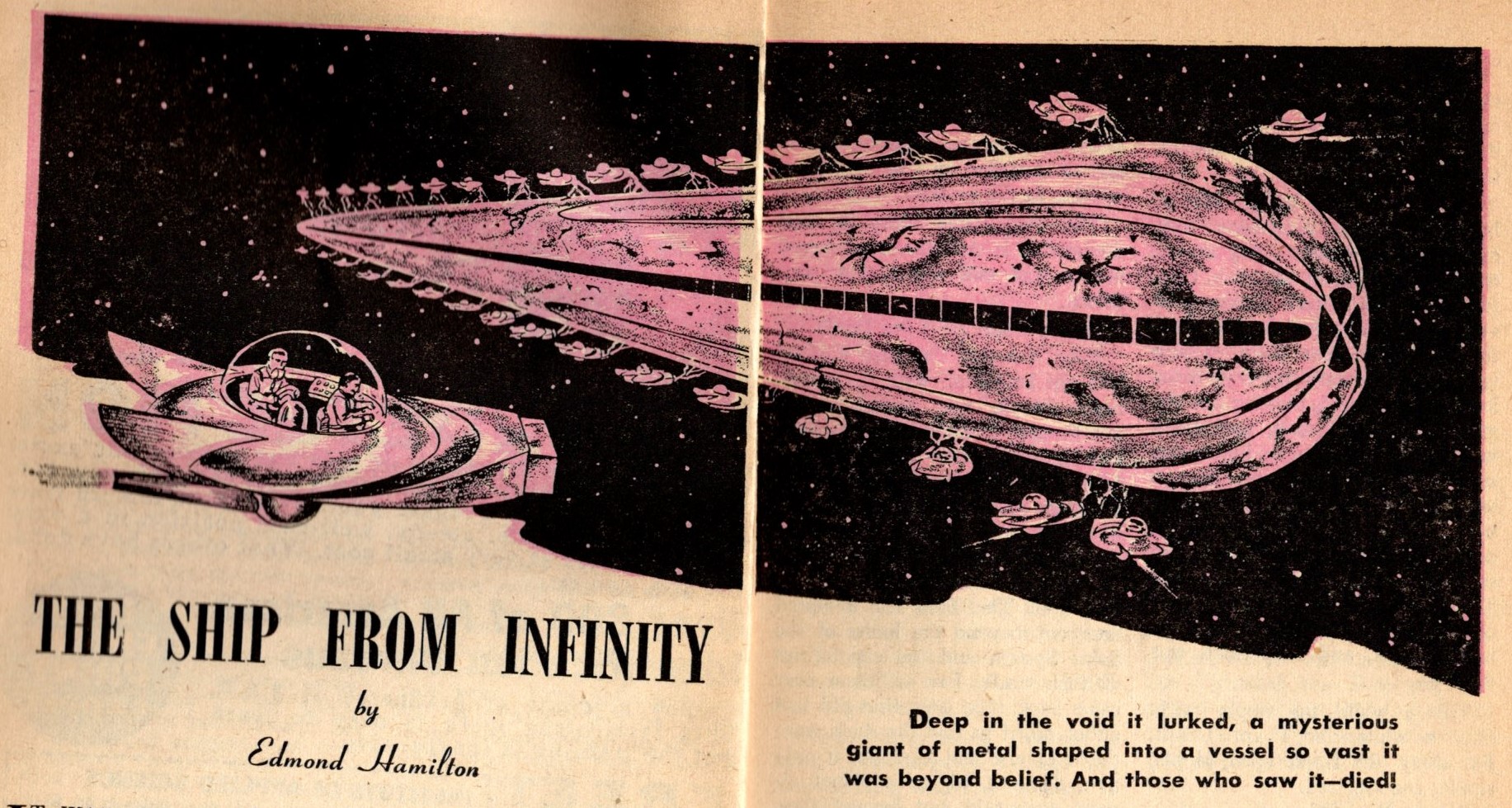
The Terran salvagers are competent enough, but they're properly dwarfed by the challenge, and one gets to feel what one expects to feel:
...It was eerie going. The darkness, the still dead desolation, were bad enough. But it was so damned big. The corridors went on forever, with hundreds of doors opening into hundreds of unnamed spaces designed for unnamed purposes by builders of an unnameable race. You gave up trying to look into every one...
our clumps can accrete beyond our ken
I'll leave you with a thought, that the clumps of human origin, such as the wreck-pack in Calling Captain Future or the space-encampment in Citadel of Lost Ships, might, by evolution, drift into a degree of alienage comparable to the mysteries of the giant derelicts of interstellar origin.
Thus the themes on this page arch round to form a circle...

...most unique to the Freak Century was the Sargasso Asteroid, a tiny planet manufactured of natural rock and wreckage, salvaged by its inhabitants in the course of two hundred years.
And so, in The Stars My Destination, we meet the degenerate "Scientific People".
They were savages, the only savages of the twenty-fourth century; descendants of a research team of scientists that had been lost and marooned in the asteroid belt two centuries before when their ship had failed. By the time their descendants were rediscovered they had built up a world and a culture of their own, and preferred to remain in space, salvaging and spoiling, and practising a barbaric travesty of the scientific method they remembered from their forebears...
Harlei: A scenario full of potential. Great for sinister, festering mysteries. Sargassos, derelicts, clumps -
Stid: All good for a lurk.
Alfred Bester, The Stars My Destination (a.k.a. Tiger! Tiger!) (1955); Leigh Brackett, "Citadel of Lost Ships" (Planet Stories, March 1943); Raymond Z Gallun, "Derelict" (Astounding Stories, October 1935); Edmond Hamilton, Calling Captain Future (1940); "The Ship From Infinity" (Imaginative Tales, November 1957); Milton Lesser, "The Graveyard of Space" (Imagination, April 1956)
See also The Original "Space Sargasso" for the development of the idea in Edmond Hamilton's work from 1931 to 1940.
Captain Future's return to the Sargasso is mentioned in Octopoid aliens becalmed in the "Sargasso of Space".










































